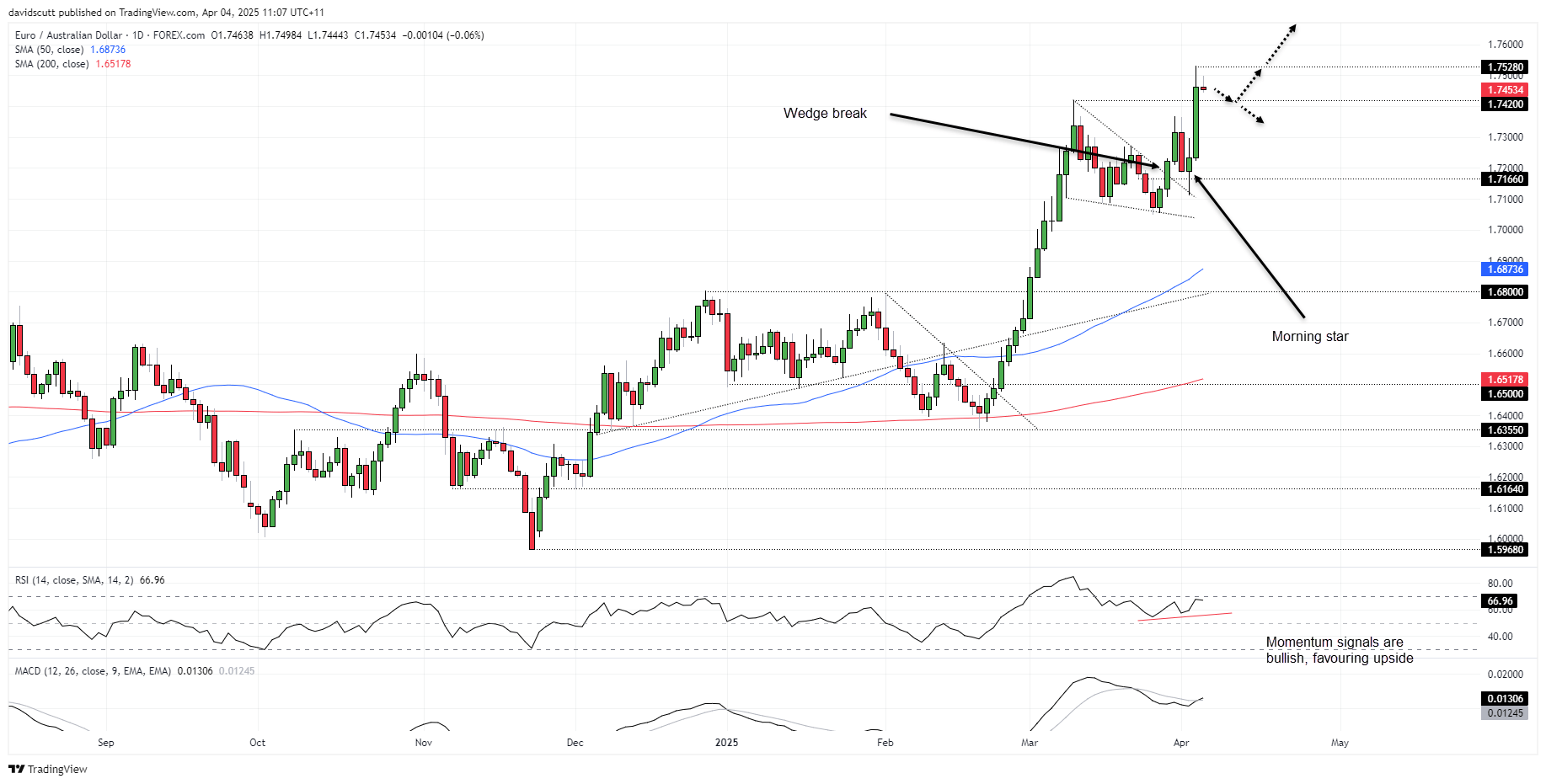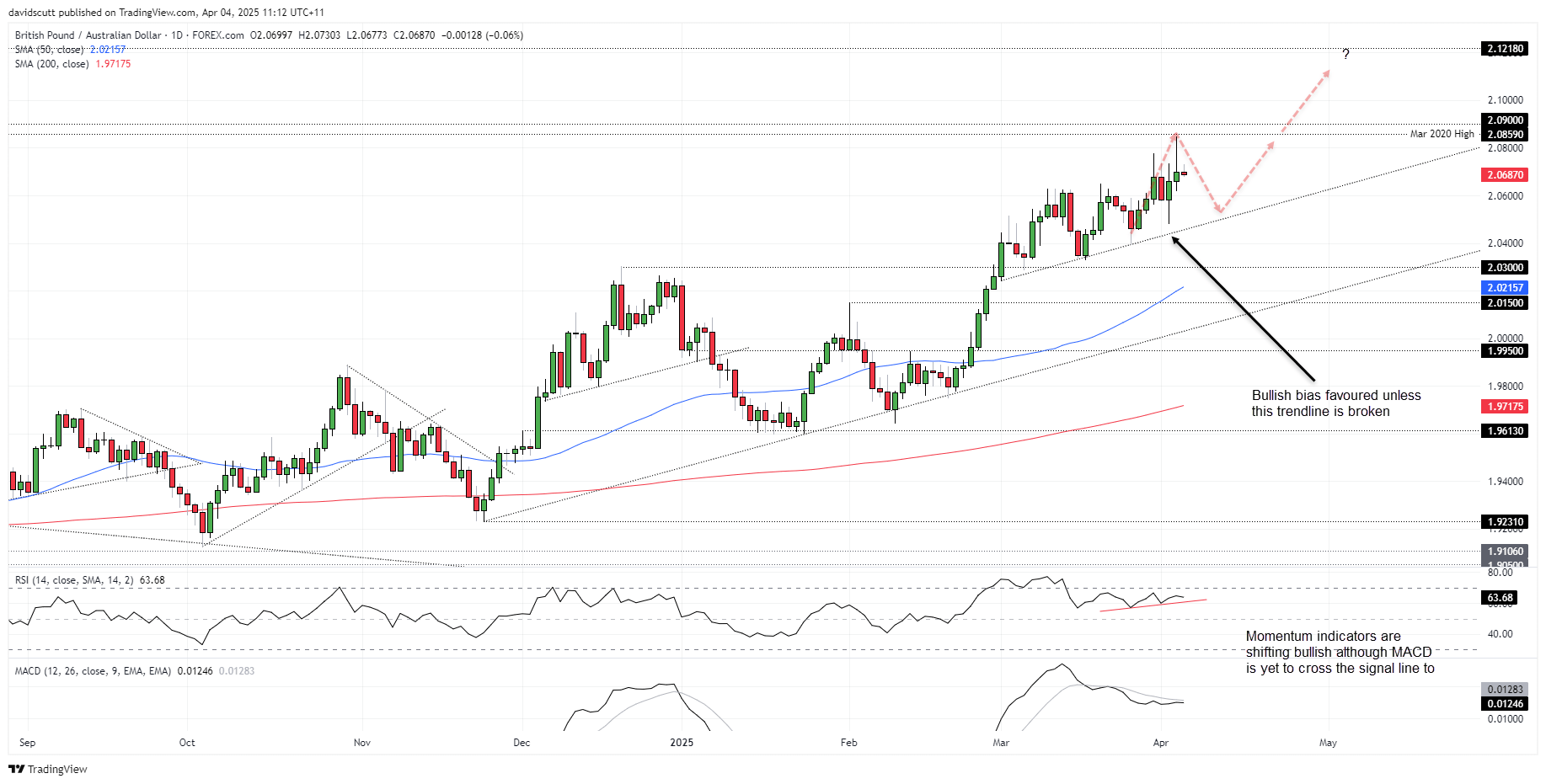- AUD underperforms on Liberation Day as risk sentiment dives.
- US hits China with additional 34% tariff, overshadowing Australia’s lighter treatment.
- EUR/AUD breaks out, eyes 1.7800; GBP/AUD nears pandemic highs.
- US payrolls report critical to short-term Aussie direction.
Given the scale of the rout in risk assets and the enormous trade barriers unveiled by the United States against China by President Donald Trump, it comes as no surprise that the Australian dollar underperformed against the euro and British pound on Liberation Day, tumbling to fresh cyclical lows.
With technical signals pointing to further downside risk, only a large turnaround in sentiment may be enough to reverse the move already seen. In the near term, that appears unlikely—especially if Friday’s U.S. non-farm payrolls report provides any whiff of impending recessionary vibes.
China Proxy Tag Hard to Shake
While Australia escaped relatively lightly on Liberation Day, with the U.S. only applying a 10% import tariff on its exports, the direct impact paled in significance to the indirect implication of the U.S. slapping Chinese exports with additional 34% levies, taking the net tariff rate on the manufacturing powerhouse to 65%.
Despite increasing the likelihood that Chinese policymakers may respond with further support measures to boost the domestic economy—something that would usually benefit Australia via increased commodity demand if it includes higher infrastructure spending—the Aussie cannot shake the long-held market mindset that it’s a China proxy, underperforming against a variety of European currencies on Thursday.
Payrolls Key for Recession Risk
While the risk of a partial reversal of Liberation Day moves is elevated considering just how far markets shifted—especially with U.S. non-farm payrolls on the horizon later Friday—it may prove tough for risk sentiment, and the Aussie, to find traction around this key market event given the current environment.
If the jobs report is strong, it may be dismissed as backward-looking considering developments this week. But if ugly, it could significantly amplify fears that the U.S. was entering a recession even before the tariffs hit. The unemployment figure will be key with a steady or lower number far more likely to result in a bounce in risk sentiment and the Aussie dollar. A spike could spark a shellacking.
EUR/AUD Risks Tilt Higher
Source: TradingView
EUR/AUD surged to levels not seen since the onset of the pandemic on Thursday, taking out the March 11 high before eventually topping out at 1.7528. That’s now the first topside level of interest for bulls, with a break of that putting 1.7800 on the radar—a level the price did plenty of work either side of in 2020.
Price signals are working in favour of the bulls, with the topside break of the declining wedge we flagged in late March eventually delivering a definitive move. The price bounced off former wedge resistance before launching higher, completing a three-candle morning star pattern in the process. That points to the risk of further upside.
Momentum signals are complicit with the bullish price setup: RSI (14) is trending higher but not yet overbought, while MACD has crossed the signal line from below above zero. The broader momentum picture therefore favours buying dips and bullish breaks in the near term.
If the price were to reverse and close beneath 1.7420, it may favour range trading rather than an outright bullish stance near term.
GBP/AUD Eyes Pandemic Highs
Source: TradingView
GBP/AUD came within a whisker of taking out the pandemic highs on Thursday, stalling just short of the mark before reversing towards the close. However, sitting in what’s quickly resembling an ascending triangle pattern, traders should be alert to the risk of a potential bullish breakout, leaving 2.1218 as a potential target if the move is sustained.
RSI (14) is trending higher but not overbought, while MACD is on the cusp of crossing the signal line above zero—an outcome that would confirm the overall bullish signal.
If the price were to reverse lower through the uptrend that began in late February, the bullish bias would be invalidated.
